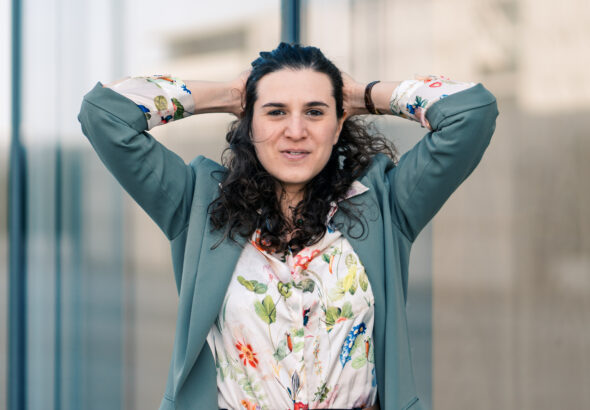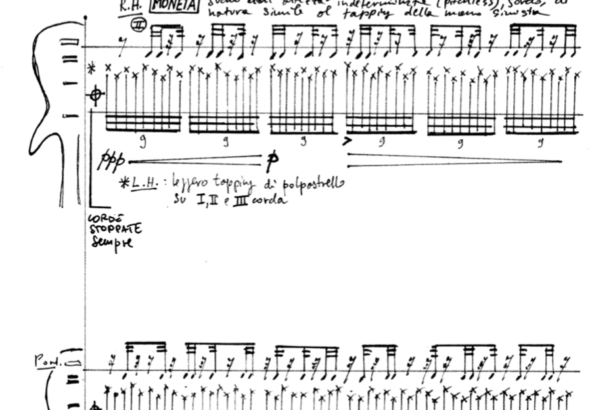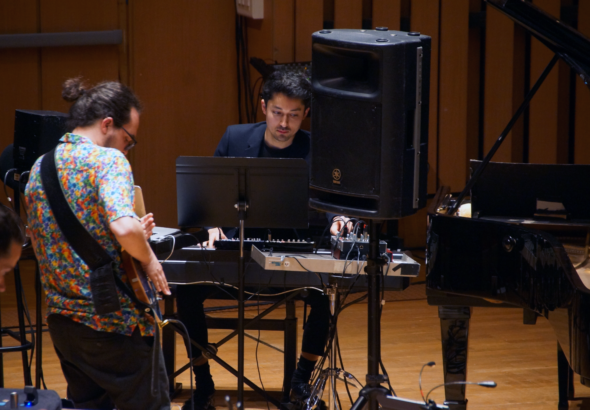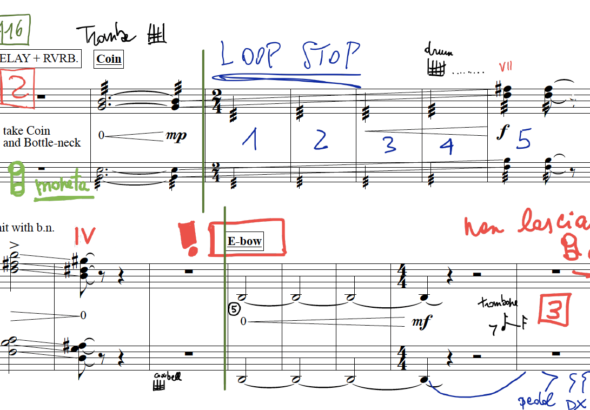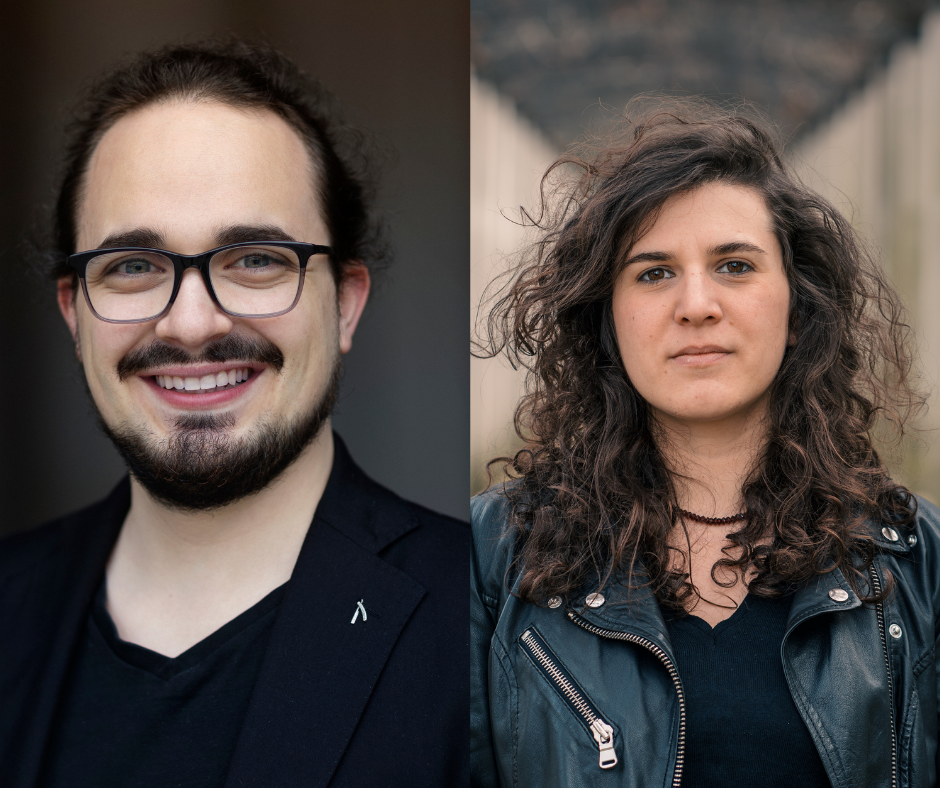
On April 17 and 25, the Parisian ensemble 2e2m paid tribute to the music of Giulia Lorusso, one of the most interesting young Italian composers on the contemporary scene. On the latter date, Natura electrica, a concerto for electric guitar and ensemble, was performed for the first time, featuring Italian guitarist Ruben Mattia Santorsa. Both protagonists of this experience are guests in this interview and will analyze with us the evolution of the writing and interpretative character of the Italian composer’s music, paving the way for a new recording project to be released in the coming months.
Ruben, Giulia, thank you for accepting our invitation. How was your recent experience in Paris?
Ruben: Paris was the culmination of a journey we started together years ago. I have been playing and knowing Giulia’s music for years, and before the April concert, we had two intense rehearsal sessions, which made my work easier once I received the score: everything was on paper, nothing was unclear, we just had to bring it to life. The concert was also an important collective moment for me: among the nearly 300 people in the audience, many friends were there, some coming from abroad specifically to listen to me and Giulia’s new piece. Without sounding trite, the Paris concert was yet another confirmation that, for me, music should be a starting point for sharing ideas, whether they are artistic, social, or political.
Giulia: It was a very beautiful moment. Ruben and I have known each other for more than ten years now: we have experimented together from the very beginning, and I started to get to know the guitar and the electric guitar thanks to him. The Paris concert was a work opportunity that we wanted and sought together. The first “Natura Electrica” sessions took place in Berlin, and the rehearsals with Ensemble 2e2m (who believed in our project) directed by Léo Margue were held in Paris. I must say that the working environment was very positive from the start: we had already collaborated with them in the past, and there was a great rapport from the very beginning.
What was the origin of your artistic partnership? And what inspired your collaboration for the Natura Electrica project?
Ruben: We met at the Internationales Musikinstitut Darmstadt in 2014 and stayed in touch in the following years. Between 2018 and 2019, we both found ourselves in Berlin. During this period, the solo “À fleur de peau” was born, which Giulia wrote for me for electric guitar. It was a real gift from her: the premiere took place during my debut in the USA, in New York. I always remember with emotion the rehearsals together in Berlin, experimenting with sounds and techniques that have now become part of my technical and artistic repertoire. I had the opportunity to perform her music in France, Italy, Germany, the USA, and Switzerland. In the following years, Giulia continued to write extensively for the instrument, and from there came my idea and proposal: why not write a concerto for electric guitar? Not only did she accept, but she also found the right opportunity after being named “composer in residence” for the season of the Parisian ensemble 2e2m, proposing this project to them.
Giulia: Ruben and I started collaborating in 2019, also due to our geographical proximity (at that time we both lived in Berlin) with a first short piece for electric guitar, “À fleur de peau”, which Ruben has performed on several occasions and in various contexts. In the following years, I wrote two more pieces for electric guitar, and my interest in this instrument has always remained alive. In 2021, we started talking about a new collaboration, this time for electric guitar and ensemble: the opportunity to work with the ensemble 2e2m arose almost by chance when Jean Philippe Grometto, then the artistic director of the ensemble, suggested I imagine a project for their ensemble. In “Natura Electrica” (a modern Latinization referring to the very essence of the electric guitar), I wanted to explore the relationship between acoustic and electric sound, considering the ensemble primarily as an extension or emanation of the guitar. The writing for the guitar, using effects such as loop and freeze, ends up permeating the writing for the ensemble as well.
Giulia, the electric guitar offers infinite possibilities and great freedom, which can be overwhelming. Where did you decide to start?
Giulia: It’s absolutely true: the electric guitar offers infinite possibilities and a freedom to radically rethink the configuration of the instrument; however, the fascination it exerted on me lies precisely in this. In “À fleur de peau” (a piece from 2019), I explored some of the sounds offered by pickups, compressor, and distortion, which allow for a sort of “zoom” on the sound, clearly bringing out sounds produced by micro-gestures and rubbing. The piece is mainly constructed with material without a defined pitch but inscribed in a dramaturgy to which instrumental gestures, variations in density and intensity, give musical coherence. Only at the end of the piece does a bicord with defined pitches emerge in the background.
Exploring effects guided you in creating Unspoken, where your research through new techniques and the use of the loop station is evident. Your writing evolved in Fabrica, a piece performed with the C Barré Ensemble, which sees the instrument as an integral part of the group. Was it difficult to incorporate the guitar into a chamber music context?
Giulia: Unspoken is a very different piece from the previous “À fleur de Peau.” My writing for electric guitar has evolved through two types of exploration: the first comes from research on resonance in two pieces for solo piano and piano with electronics, which are “Déserts” and “Entr’ouvert.” The second type of exploration happened directly on the electric guitar through a piece/study composed between 2018 and 2019, initially titled “À fleur de peau II” and now, revised and rewritten for electric guitar and tape, called “Drift.” In this piece, I had extensively used the loop station (sometimes unknowingly pushing beyond the limits allowed by existing pedals). “Unspoken” (2021) definitely reflects these two experiences. In “Fabrica” (2020), the electric guitar integrates with the ensemble and electronics, utilizing some techniques already explored in “À fleur de peau” and “Drift,” and in some parts anticipating the sounds of “Unspoken.”
Ruben, how did you approach interpreting Giulia’s pieces? Did you adopt any particular approaches or encounter specific difficulties?
Ruben: As I previously mentioned, I was fortunate to work closely with Giulia from the very beginning, even before there was an idea of the piece, a form, or even a clear picture of the situation. The mutual exchange was immense: she had an idea, I found solutions to put it into practice, and we discussed it from the ground up. Without taking any credit for Giulia’s compositional and sonic ideas, I think this was a genuine collaboration where we significantly influenced each other.
Have you noticed a transformation in your sound from one piece to another over the years?
Ruben: The change is constant. Even today, when I revisit her pieces, I continue to work on the patch and the sound, sometimes altering very small parameters. My knowledge of pedals and the instrument evolves progressively, as do my sonic needs and my research advances. Hence, there is a necessity for continuous renewal, even in sounds that have already been defined and crystallized.
How did you prepare for the role of soloist in Natura Electrica? Did you use a different study method compared to other occasions?
Ruben: The first days were entirely dedicated to programming the various sounds. Once I had a clear understanding of the score, I focused on the instrumental part afterward. Since we didn’t have many rehearsals, I prepared several patches with different parameters so I could quickly change my sound without making the whole ensemble wait. In a concerto for electric guitar and ensemble, the most challenging aspect is blending the electric sound with the acoustic one. My approach wasn’t that different; being a soloist entails more responsibility, but even when playing as a guest in an ensemble, I often study the score to have a better overall vision. Léo Margue did an exceptional job: during rehearsals, we talked a lot about music, and his energy transformed the sound and attitude of the ensemble. Despite the few rehearsals, he managed to express himself brilliantly.
It seems that this latest project is just a starting point for the release of the next monographic album dedicated to Giulia’s guitar music. What can we expect in the future?
Ruben: By the end of 2024, we will release a vinyl with the label “Dissonant Bear” featuring the three solo pieces for electric guitar written by Giulia. We recorded them last year in Paris. It is the first monographic project dedicated to her, and I am happy that it is entirely focused on the electric guitar. Not many composers have written several solo pieces for this instrument; having three and being able to make a record is a privilege. The goal is to continue working together for 2025 and 2026. I believe in long-term artistic collaborations.
Giulia: In the future, the collaboration with Ruben continues with a concert in December 2024 for the Amici della Musica di Firenze: a concert entirely dedicated to the electric guitar, with the inclusion of electronics, where we will also premiere a new project, “Natura Alchemica.” This project is somewhat a continuation of “Natura Electrica” but also engages in a dialogue with the music of past composers like Hildegard von Bingen, Orlando di Lasso, Francesca Caccini, Barbara Strozzi, Maddalena Casulana…





